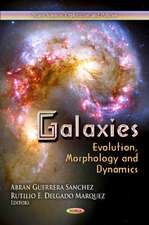Fundamental Stellar Properties: The Interaction Between Observation and Theory: Proceedings of the 189th Symposium of the International Astronomical Union, Held at the Women’s College, University of Sydney, Australia, 13–17 January 1997: International Astronomical Union Symposia, cartea 189
Editat de Timothy R. Bedding, Andrew J. Booth, John M. Davisen Limba Engleză Paperback – 31 iul 1997
Din seria International Astronomical Union Symposia
-
 Preț: 132.74 lei
Preț: 132.74 lei -
 Preț: 404.67 lei
Preț: 404.67 lei -
 Preț: 400.65 lei
Preț: 400.65 lei -
 Preț: 412.95 lei
Preț: 412.95 lei - 15%
 Preț: 660.68 lei
Preț: 660.68 lei - 15%
 Preț: 654.43 lei
Preț: 654.43 lei -
 Preț: 407.98 lei
Preț: 407.98 lei - 18%
 Preț: 1238.74 lei
Preț: 1238.74 lei - 15%
 Preț: 659.53 lei
Preț: 659.53 lei -
 Preț: 409.89 lei
Preț: 409.89 lei - 18%
 Preț: 1556.77 lei
Preț: 1556.77 lei - 18%
 Preț: 1852.43 lei
Preț: 1852.43 lei - 18%
 Preț: 1235.57 lei
Preț: 1235.57 lei -
 Preț: 419.14 lei
Preț: 419.14 lei -
 Preț: 414.52 lei
Preț: 414.52 lei -
 Preț: 417.41 lei
Preț: 417.41 lei - 15%
 Preț: 647.73 lei
Preț: 647.73 lei - 18%
 Preț: 967.56 lei
Preț: 967.56 lei - 18%
 Preț: 1236.06 lei
Preț: 1236.06 lei -
 Preț: 407.39 lei
Preț: 407.39 lei - 15%
 Preț: 654.12 lei
Preț: 654.12 lei -
 Preț: 416.26 lei
Preț: 416.26 lei - 18%
 Preț: 960.78 lei
Preț: 960.78 lei - 18%
 Preț: 1239.67 lei
Preț: 1239.67 lei - 18%
 Preț: 1239.85 lei
Preț: 1239.85 lei -
 Preț: 416.26 lei
Preț: 416.26 lei -
 Preț: 421.82 lei
Preț: 421.82 lei - 18%
 Preț: 1238.42 lei
Preț: 1238.42 lei -
 Preț: 416.26 lei
Preț: 416.26 lei -
 Preț: 405.28 lei
Preț: 405.28 lei - 18%
 Preț: 1220.54 lei
Preț: 1220.54 lei - 18%
 Preț: 1239.19 lei
Preț: 1239.19 lei - 18%
 Preț: 961.41 lei
Preț: 961.41 lei -
 Preț: 407.39 lei
Preț: 407.39 lei - 18%
 Preț: 961.86 lei
Preț: 961.86 lei - 15%
 Preț: 652.49 lei
Preț: 652.49 lei - 18%
 Preț: 1238.74 lei
Preț: 1238.74 lei - 18%
 Preț: 962.49 lei
Preț: 962.49 lei
Preț: 650.86 lei
Preț vechi: 765.72 lei
-15% Nou
Puncte Express: 976
Preț estimativ în valută:
124.56€ • 135.25$ • 104.63£
124.56€ • 135.25$ • 104.63£
Carte tipărită la comandă
Livrare economică 23 aprilie-07 mai
Preluare comenzi: 021 569.72.76
Specificații
ISBN-13: 9780792346524
ISBN-10: 0792346521
Pagini: 478
Ilustrații: XXIX, 478 p.
Dimensiuni: 155 x 235 x 26 mm
Greutate: 0.71 kg
Ediția:Softcover reprint of the original 1st ed. 1997
Editura: SPRINGER NETHERLANDS
Colecția Springer
Seria International Astronomical Union Symposia
Locul publicării:Dordrecht, Netherlands
ISBN-10: 0792346521
Pagini: 478
Ilustrații: XXIX, 478 p.
Dimensiuni: 155 x 235 x 26 mm
Greutate: 0.71 kg
Ediția:Softcover reprint of the original 1st ed. 1997
Editura: SPRINGER NETHERLANDS
Colecția Springer
Seria International Astronomical Union Symposia
Locul publicării:Dordrecht, Netherlands
Public țintă
ResearchCuprins
1. Introduction.- Introductory overview.- 2. Stellar Distances.- The Hipparcos results.- Review of CCD parallax measurements.- Stellar distances by the Baade-Wesselink method.- 3. Stellar Angular Diameters and Radii.- Stellar angular diameter measurements by interferometry.- Astrometry Using Interferometry at Optical Wavelengths.- Lunar occultation measurements of stellar angular diameters.- Stellar radii.- 4. Stellar Flux Distributions.- The visual and infrared flux calibrations.- Review of the ultraviolet flux calibration.- The bolometric luminosities of stars.- The colours of the Sun.- The ISO-SWS flux standard stars: synthetic spectra and observations.- UV energy distributions of active cool stars.- 5. Stellar Masses and Surface Gravities.- Precise stellar mass and mass-luminosity data.- Interferometric measurements of binaries.- Determining the masses of white dwarfs in magnetic cataclysmic variables from x-ray observations.- Empirical surface gravities.- 6. The Stellar Effective Temperature Scale.- Cool star empirical temperature scales.- The effective temperatures of hot stars.- The stellar temperature scale from angular diameters and flux distributions.- Stellar effective temperatures through the infrared flux method.- Tests of effective temperature — colour relations.- 7. Stellar Abundances.- Review of abundances for mid-Teff stars.- The broadening of metallic lines in cool stars.- Abundances of the elements in the halo stars — interaction between observation and theory.- Abundance anomalies in globular clusters.- Stellar parameters in the bulge cluster NGC 6553.- 8. Stellar Atmospheres.- Non-LTE line blanketed atmospheres for hot stars.- Progress on model atmospheres and line data.- Atmosphere models for very low mass stars, brown dwarfs and exoplanets.-Parameter identification — a new way of assessing errors in stellar atmosphere analysis.- Atmospheric motions and granulation in cool stars — observations and theory.- Chromospheres, activity and magnetic fields.- Pulsating stellar atmospheres.- What do we do when models don’t fit? On model atmospheres and real stellar spectra.- 9. Stellar Oscillations and Pulsations.- Observing solar-like oscillations.- Constraints on stellar interior physics from helioseismology.- Bulge ? Scuti stars in the MACHO database.- Properties of Cepheids and long-period variables.- RR Lyrae variables.- 10. Stellar Models Versus Observations.- The evolution of massive stars.- Evolution of intermediate mass stars.- Theory of low mass stars, brown dwarfs and extra-solar giant planets.- 11. Stellar Interiors.- Rotation: a fundamental parameter of massive stars.- The effect of rotation on RGB surface abundances.- The importance of helium and metals diffusion in stars.- 12. Evolved Stars.- Non-variable horizontal-branch stars.- NLTE analyses of PG 1159 stars: constraints for the structure and evolution of post-AGB stars.- The Asymptotic Giant Branch.- Cool white dwarfs: atmosphere, cooling and galactic implications.- Theory, observation and experiment: stellar hydrodynamics.- Summary and review: Interaction of observations and theory of stellar interiors.- 13. Stellar Chemical Evolution.- Stellar chemical evolution.- Chemical evolution of galaxies — challenges for stellar astronomy.- 14. Stellar Ages.- New model atmosphere analysis of cool white dwarfs: a revised luminosity function and constraints on the age of the Galaxy.- Hipparcos subdwarfs and globular cluster ages: towards reliable absolute ages.- Globular cluster ages: are they converging?.- 15. Conclusion.- Achievements andprospects.- Discussion.- Indexes.- Author Index.- Object Index.














